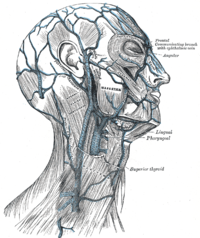
Photo from wikipedia
Abstract Background and objectives There are different ultrasound probe positions used for internal jugular venous catheter placement. Also, in-plane or out of plane needle approach may be used for catheterization.… Click to show full abstract
Abstract Background and objectives There are different ultrasound probe positions used for internal jugular venous catheter placement. Also, in-plane or out of plane needle approach may be used for catheterization. Transverse short-axis classic approach is the most popular performed approach in literature. “Syringe-Free” is a new described technique that is performed with oblique long-axis approach. We aimed to compare performance of these two approaches. Methods This study was conducted as a prospective and randomized study. 80 patients were included the study and allocated into two groups that were named Group C (transverse short-axis classic approach) and Group SF (oblique long-axis syringe-free approach) by a computer-generated randomization. The primary outcome was mean time that guidewire is seen in the Internal jugular vein (performing time). The secondary outcomes were to compare number of needle pass, number of skin puncture and complications between two groups. Results Demographic and hemodynamic data were not significantly different. The mean performing time was 54.9 ± 19.1 s in Group C and 43.9 ± 15.8 s in Group SF. Significant differences were found between the groups (p = 0.006). Mean number of needle pass was 3.2 (± 2.1) in Group C and 2.1 (± 1.6) in Group SF. There were statistically significant differences between two groups (p = 0.002). The number of skin puncture was 1.6 (± 0.8) and 1.2 (± 0.5) in Group C and SF, respectively (p = 0.027). Conclusion “Syringe-Free” technique has lower performing time, number of needle pass and skin puncture. Also, it allows to follow progress of guide-wire under continuous ultrasound visualization and the procedure does not need assistance during catheter insertion. Namely, “Syringe-Free” is effective, safe and fast technique that may be used to place internal jugular venous catheter.
Journal Title: Revista Brasileira De Anestesiologia
Year Published: 2018
Link to full text (if available)
Share on Social Media: Sign Up to like & get
recommendations!